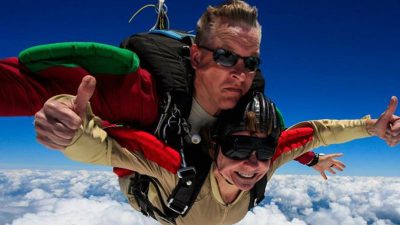Every decision in life has some measure of associated risk. Assessing the potential danger involved in our actions has, in fact, been one of the very keys to our survival as a species. Because experiencing danger is – by the very nature of our existence – inescapable, risk must be gauged in relation to the benefits or rewards to be reaped. Take skydiving for example. Skydiving, for many, is an empowering, actualizing, and transformative experience; an experience they decide is worth the associated risk.
Before participating yourself, though, it’s natural to wonder, how dangerous is skydiving? While the risk-reward ratio may be well and good for others, you, dear reader, don’t have to simply trust and follow suit. Here are the most recent safety statistics concerning the sport of skydiving.
Skydiving Statistics
For those with a discerning eye for data, skydiving statistics speak louder than words. Let’s get down to the numbers. For the last decade, over 3 million estimated jumps have been made each year – the outlier being 2020 which had an estimated 2.8 million skydives; the decrease, of course, due to pandemic-related dropzone closures.
Out of the 2.8 million skydives that occurred in 2020, there were a total of 11 skydiving fatalities. This is a rate of 0.39 fatalities per every 100,000 skydives or a 0.00039% chance of dying on a skydive. Although the final data on the total number of jumps completed in 2021 is not yet available, with an all-time low of 10 fatalities, 2021 is believed to be the safest year to date for U.S. Skydiving.

It should be noted that these statistics relate primarily to solo skydives. Tandem skydiving, where you are attached to an instructor, has data that is even more reassuring. So, how dangerous is tandem skydiving? Over the past 10 years, the average has been one student fatality per 500,000 jumps. Statistically, this is a 0.0002% rate of a fatal incident.
Comparatively, according to the National Safety Council, the odds of dying in a car crash are an astounding (and frankly, terrifying) 1 in 107 or alternatively a 0.9% rate of a fatal incident.
Skydiving Safety
While those unfamiliar with skydiving might believe that faulty equipment causes most skydiver fatalities, this is not the case. In general, human error is to blame.
No equipment is infallible, but rigorous testing before public consumption significantly decreases the number of incidents of failure. Case in point, modern skydiving equipment undergoes exhaustive testing that exceeds normal jump stresses. All skydiving systems include a main and a reserve parachute. Additionally, all parachute systems used by student skydivers (tandem skydiving included) utilize an automatic activation device (AAD). This invaluable advanced safety feature deploys the reserve parachute if the main parachute does not deploy. The majority of licensed skydivers also jump using a parachute AAD.
Unfortunately, the skydiving fatalities that occur most often involve licensed, experienced skydivers who attempt advanced maneuvers and make a critical error in judgment where the margin for error is slim to none. In other words, the majority of fatalities are the fault of the pilot, not the parachute.

Is Skydiving Worth the Risk?
Although skydiving is not risk-free, the risks involved are significantly mitigated by advancements in skydiving technology, strict safety standards, and improved skydiving training. From the many who walk through our doors to the millions worldwide who jump each year, it would seem the answer is a resounding yes: skydiving is worth the risk. Ultimately, though, each individual must decide for themselves whether or not the experience of skydiving is worth it.
At Skydive Monroe we respect every guest, especially those who decide to do a little research before participating in skydiving. If you’re looking for more information or have questions regarding the specific safety measures taken here at Skydive Monroe, please reach out. We’re happy to help!
Copyright © 2025, Skydive Monroe, All Rights Reserved.
DropZone Web Design & Marketing by Beyond Marketing, LLC



